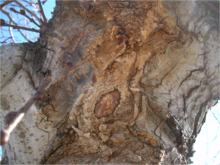| Slime flux | |
|---|---|
 Slime flux on a Camperdown Elm caused by Pectobacterium carotovorum. Note the ooze (dark ring in the center) and the discoloration of the bark. | |
| Causal agents | Bacteria (Brevundimonas bullata, Paracoccus alcaliphilus, P. marcusii and Luteimonas aestuarii, and Pectobacterium carotovorum) |
| Hosts | Trees (elm, cottonwood, poplar, boxelder, ash, aspen, fruitless mulberry and oak) |
| EPPO Code | ERWICA |
Slime flux, also known as bacterial slime or bacterial wetwood, is a bacterial disease of certain trees, primarily elm, cottonwood, poplar, boxelder, ash, aspen, fruitless mulberry and oak. A wound to the bark, caused by pruning, insects, poor branch angles or natural cracks and splits, causes sap to ooze from the wound. Bacteria may infect this sap causing it to darken and stain the bark, eventually taking on a foamy appearance and unpleasant odor. This slimy ooze becomes toxic to the bark and eats into the tree. The fermented sap attracts insects like flies, ants, and maggots.